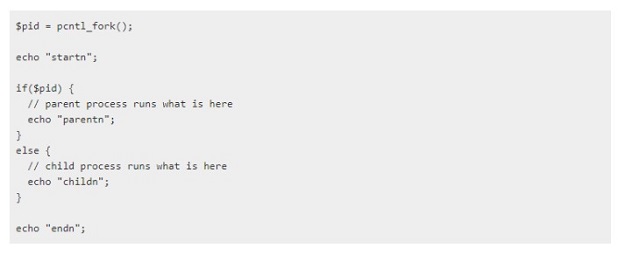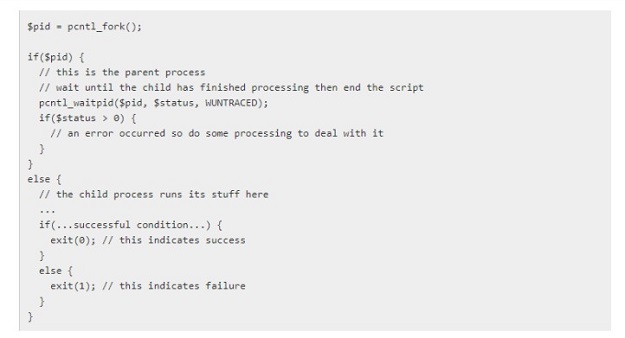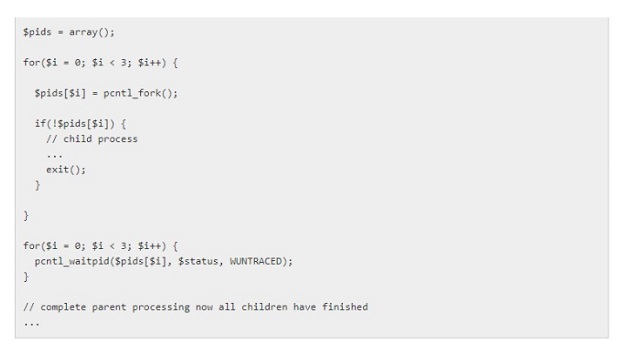PHP apps, and PHP development services no doubt work effectively with multithreading abilities. What is multithreading in PHP? It’s actually something that’s the same as multitasking. It however allows numerous tasks at one time, instead of multiple processes.
Because jobs are smaller, and more basic instructions compared to processes, multithreading could happen within processes. The multitasking capability for instance allows web browsers to have several windows open with JavaScript and Flash animations simultaneously running. In a program that’s completely multithreaded, every process runs without effect on other processes that run simultaneously, so long as the CPU will retain ample power for handling them.
1. Multithreading, much like multitasking, progresses the stability of programs as well. When PHP multithreading was not so popular in the coding world, there was no genuine solution for equalizing long tasks. A PHP developer was dependent on forking via pcntl_fork that includes its own problems and adequate handling of results was hard.
Thus, the use of PHP multithreading comes as favorable in the community. Some of the benefits of PHP multithreading are the following:
2. Responsiveness. Responsiveness of a program enables it to run even if a part of it is blocked with the use of multithreading. Also, this could be done if the process is doing a long operation. Take for instance a web browser that has multithreading could utilize a single thread for user contact and another for loading images at the same time.
3. Sharing of Resources. All process threads share resources like data, memory, files, and so on. One app could have several threads in the same address space, that use resource sharing.
4. Multiprocessor architecture utilization. Every thread in a multiprocessor architecture could run in parallel on a different processor with multithreading. This boosts system concurrency. Also, this is a direct opposite to only one processor system in which just one thread of process could run on a processor at a time.
Economical. Using threads is more economical since they share the process resources. It is relatively more expensive and takes a lot of time to build processes since they require more resources and more memory. The overhead cost for creation and the management of a process is significantly higher compared to building and managing thread.
Don’t Miss-
PHP Coding Standards Your Offshore Dedicated PHP Developers Should Know
Cake PHP vs. Laravel: What You Should Know About these Frameworks
Set up Task/Job Queues with a Web Server Software
The method enables you to use multiprocessor servers to efficiently distribute tasks that are processor-intensive. A data ‘message’ is packaged up, which is all the data needed to do a task, coded into a JSON string usually. The message is then sent to a queuing machine, such as RabbitMQ, Beanstalk, Redis, and so on.
A daemon process will consume the messages on que a limited rate, choosing tasks and utilizing a HTTP POST for forwarding a message to a script that’s hosted on a web server. The web server software, like Apache and others for instance, handles the child processes in the same way as when users hit the hosting of a website.
The advantages include easy implementation, despite the apparently complex setup, accessibility to any developer who understands the architecture of a generic web stack, which could understand how the process works fast. Moreover, it’s also scalable, thus there would be no problem for bigger queues that process longer.
The main drawback however is that not all the systems lend themselves into this architecture. If requirements processing is on-demand, they could result in idle server time that could cost money. The method is suitable if you need processing of near constant batch.
Pcntl_Fork Process Forking
Forking is a process that enables a parent process to spawn a sub-process and continue to concurrently run on both processes. This is possible in PHP, and PHP web development companies could do this with the use of the PHP Process Control Functions.
However, keep in mind that you should not attempt using the process control forking functionalities when you use a web server. For apps only when you utilize the PHP command line client.
Enabling the Pcntl Extension
Before you could use the process control functions of PHP, you need to compile the PCNTL extensions to PHP with the –enable-pcntl configure option or use the package manager of the distribution for installing it. You don’t need pre-installed additional libraries.
Basic Forking, an Example
A commonly used, very basic forking example in PHP.

When you run this, you get this output.
The copy of a parent process is called the child process.
What actually occurs when calling a pcntl_fork function is a child process is spawned, which is the same as the parent process. From the line below the function call, it continues processing. All objects, variables and others are copied to the child process as-is.
These copies however belong to the new process. Making changes to them in the child process will not affect the parent process values. A parent process would have a value assigned to $pid, but the child process won’t, thus the if test.
The above example showcases that both processes will continue to run whatever the code may be after the if statement. This is something that’s not often mentioned in the PHP process forking examples on the web. Let us modify the above example a bit to illustrate this point, adding additional output such as:
When you run this, the following will be displayed:
Ideally, you want to let either the parent or child continue to process the rest of the script, and make the other processes exit after it’s forked. However, if you exit from the parent process, you could end up with ‘zombie’ processes that don’t belong to any process. Thus, before exiting, the parent process should wait until all child processes have finished running.
This could be done with pcntl_waitpid() functionality that could make the parent process wait until the completion of the child process. Either you could just allow the parent process to exit, or perform tidying up of code that’s required.
In the parent process, the exit call ascertains that processing will cease at that point, and the parent won’t execute any code meant for the child. Another way to do the same thing without exit code will be like this:
You have the option to exit the call at the end of the if statement of the child part. The status parameter passed into the pcntl_waitpid9) stores the child process return value. If a child process returns 0, it would then also be zero. Getting the parent process wait until completion of the child process is useful for performing some other task, based on the return value on the child process, like the following:
Forking several child processes
This is a final illustration of how you could fork several children processes from the parent process using PHP. The loop runs three times, forking a child process for every loop, and stores pids to an array. The child takes an exit then after running stuff for the child process.
After the first loop, a second loop runs in the parent to make sure that all child processes have finished running before it resumes its own process. In this process, it’s very important for a child to exit explicitly in its script section, otherwise every child would go on running via the first loop, and so on.
Asynchronous Processing
Developers depend on asynchronous PHP calls in order to fulfill requests without bogging the app down. So, what’s asynchronous PHP? It refers to PHP code written with the use of an asynchronous model.
Simply, asynchronous apps could do multi-tasking. The idea behind it is to take full advantage of all the CPU cycles available for boosting the performance of the PHP framework. It does this by keeping non-blocking I/O tasks to run in the background, as well as enabling the CPU to process other tasks as it waits for the needed instructions and data to accomplish the I/O tasks.
Through making it possible for apps to manage a lot of requests at the same time, they could fully benefit from the hardware resources available that could enhance service levels and ROI at the same time. Asynchronous processing boosts the performance of PHP since it allows managing and completing several tasks at the same time. Using it could dramatically improve PHP performance than synchronous PHP.
You could boost performance of PHP in several benchmarks by 100 times through allowing asynchronous PHP through Swoole, compared to utilizing a process accelerator like php-fpm that has synchronous code. This is because php-fpm does not provide asynchronous support, and communications in real-time with protocols like WebSockets.
# Benefits of Asynchronous PHP
Refactoring apps to support the asynchronous processes could require a bit of effort. By doing so however, you could:
1. Maximize the use of hardware
2. Boost the user experience and PHP performance
3. Reduce data center footprint
Conclusion
Multithreading in PHP is possible. PHP apps are able to build, read, write, execute, and synchronize Workers, Threads, and Threaded objects.
However, keep in mind that pthreads extension could not be utilized in a web server environment. PHP threading therefore should remain only to CLI-based apps.








